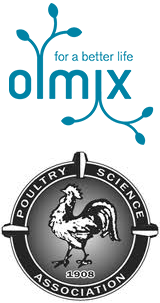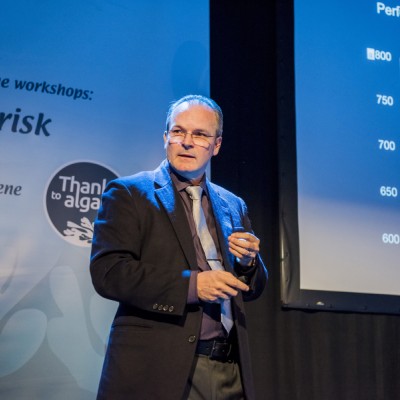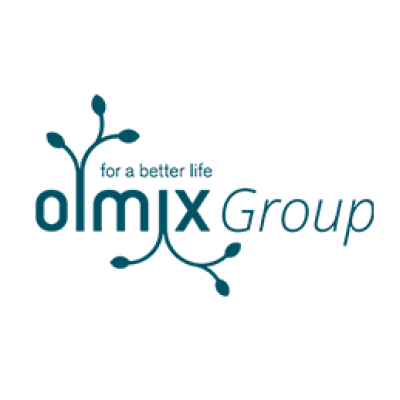
OLMIX SYMPOSIUM
2019 PSA Annual Meeting
18-07-2019 Montreal, Québec | Canada
Olmix Symposium in the official program of the PSA Annual Meeting
Download the official programme (pdf)>>
Remember to register for the meeting at PSA Annual Meeting website>>
Mycotoxin Risk Management and Gut Health in Poultry
Importance in Modern Poultry Production and Innovative Solutions to Support it

Chair
Ms Danièle Marzin
Olmix Group Marketing Director
This symposium will investigate the importance of the immune system and gut health in the current context of poultry production and update the poultry community on mycotoxin risk and its effects on poultry gut health and immunity. It will investigate the latest available diagnostic technologies to monitor animals’ exposure to mycotoxins and markers for gut health, approach the notion of risk level, review prevention methods, immune system modulation to support productivity, from a good monitoring of its status to the use of innovative and natural in-feed solutions to support it.18
Jul
Development of the immune system in poultry
8:00 - 8:40
Prof. Dr. med. vet. Bernd Kaspers
Professor for Animal Physiology - University of Munich (Germany)
The avian immune system presents some unique features that are genetically determined. Post hatch environmental conditions and bacterial colonization of the gut play an important role in the maturation of the immune system whereas the role of nutritional factors remains poorly understood.
Cost of impaired immunity and implication in the field
8:40 - 9:20
Prof. dr. Filip Van Immerseel
Researcher at Ghent University
Nowadays, the rating of the important organs is changing; the gut has become increasingly important, partly because of its implication in immune functions. To have a good performance, it is necessary to quantify both the cost of impaired immune response and the cost of activating the immune system.
Mycotoxin toxicity: notion of risk level and interaction between fusariotoxins at the intestinal level
9:20 - 10:00
Dr. Isabelle Oswald
INRA - TOXALIM UNIT, France
Among mycotoxins, fumonisin B1 and deoxynivalenol have a great impact on zootechnical parameters. These mycotoxins are not only locally toxic for the intestine, but also dysregulate many intestinal functions and impair the local immune response. This results in systemic toxicity leading to many symptoms. Feed contamination with mycotoxins also impair the barrier function of the intestine, leading to translocation of bacteria across the intestine and thus intestinal and systemic infections.Coffee break

Managing mycotoxins at the speed of light: Application of the NIR technology for mycotoxin analysis
10:30 - 11:10
Prof. Carlos Mallmann
Laboratory of Mycotoxicological Analysis (LAMIC, Brazil)
Mycotoxin analysis is a key tool in mycotoxin risk management in the feed. The control of raw materials must be accurate and quick to be an efficient decision-making tool. Recently, the fast, simple and low-cost technology for the detection of mycotoxins that employs near-infrared spectroscopy – NIR is developed and is a very promising alternative for the feed industry.
Mycotoxin detoxification strategies of feed in Europe, a review
11:10 - 11:40
Ms María Ángeles Rodríguez
Olmix For Feed Product Manager
One strategy for reducing animals’ exposure to mycotoxins is to decrease mycotoxin bioavailability by incorporating various mycotoxin-detoxifying agents in the feed. Facing the abundance of available candidate detoxifying agents, screening methods are needed to evaluate their efficacy and select appropriate materials. A wide variability of results is observed, depending on the method and mycotoxin used.
Roundtable Discussion
11:40
Also in the program… Olmix oral presentations within other sessions of the 2019 PSA Annual Meeting
16
Jul
Algal polysaccharides to improve gut health
Session: 5-Minute Abstract Presentations
14:55 - 15:00
Ms Danièle Marzin
Olmix Group Marketing Director
ABSTRACT
María García1, María Angeles Rodríguez1, Mustapha Berri2, Christel Rousseaux3 and Pi Nyvall-Collen1
1Olmix Group, Bréhan, France; 2INRA, Nouzilly, France; 3Intestinal Biotech Development, Lille, France
The cell wall of marine algae is mainly composed of water soluble sulfated polysaccharides with several biological activities such as modulation of the immune response and reinforcement of gut barrier function. The present study aimed at assessing the ability of different seaweed extracts on improving gut health. The first part of the word tested a specific extract from green algal Ulva sp to upregulate the expression of immune mediators and the molecular mechanisms underlying this immunomodulatory activity by identifying the cell receptor and the signaling pathways involved. The second part of the work focussed on the the potential enhancement properties of a red algal extract from Solieria Chordalis on intestinal integrity using in vitro cell models HT-29 MTX and Caco-2 cells, under physiological and inflammatory conditions. Results showed that Ulva sp extract has the capacity to upregulate the expression of immune mediators: TNFα, CCL20, IL-1α, TGF-β that are involved in cell differentiation and proliferation, recruitment of immune cells and anti-inflammatory activities. Ulva sp extract interacts with TLR4 and TLR2 and leads to rapid activation of transcription factors PI3K and NF-κB. The red algal extract was shown to upregulate the expression of different target genes related to claudin-2, ZO-1 and ZO-2. The red algal extract upregulates the expression of mucin targeted genes: MUC4, MUC2, MUC5B and MUC5AC. The combination of both algal extracts can reinforce gut health targeting barrier function which is the first line of mucosal defense and via modulation of local innate and adaptive immune responses and induction of anti-inflammatory activities. The use of macroalgal sulfated polysaccharides can play an important role within the reduction of antibiotics in farms.
18
Jul
Effect of an algae-clay complex on digestive enzyme activity and performance of broiler chickens fed a corn-soy based diet
Session: Metabolism and Nutrition: Feed Additives IV
13:00 - 13:15
Ms María Ángeles Rodríguez
Olmix For Feed Product Manager
ABSTRACT
Marie Gallissot1, Rodrigo Jacob2, Luiz Fernando Albino2, Horacio Rostagno2, Raquel Pereira1, Mariel Tavares1, Maria Angeles Rodriguez1
1Olmix, Bréhan, France; 2Department of Animal Science, University of Viçosa, Viçosa, Minas Gerais, Brazil
Improving feed digestibility is a multi-faceted issue in animal nutrition. It contributes to improve livestock farming sustainability, by optimizing the use of available resources and by reducing environmental emissions, while increasing farming profitability. This study was set up to evaluate the effect of supplementing an algae-clay complex (ACC) on digestive enzyme activity and growth performance of broiler chickens fed with a corn-soy diet. The experiment was conducted at the Federal University of Viçosa (Brazil). Six hundred and sixty 1-day-old Cobb 500 male chicks were randomly distributed to 3 treatments with 10 replicates per treatment and 22 chicks per experimental unit, allocated to 1 of 3 groups receiving different diets: the standard diet (C) based on corn and soybean meal, the test diet 1 (T1), being the standard diet supplemented with 0.1% of ACC, and the test diet 2 (T2), being the standard diet supplemented with 0.2% of ACC. Animal’s performance was evaluated by measuring weight gain, feed consumption and feed conversion ratio for each feeding phase. Moreover, duodenum samples were collected at 35 days, two hours after the last feeding, from 3 chickens per replicate (30 chickens/treatment) to perform digestive enzyme activity assays. The activity of amylase (using starch) and chymotrypsin (using BTEE substrate) were measured by spectrophotometer in kinetic assay. Results showed a tendency to increase weight gain for groups T1 and T2 compared to control, though it was not statistically significant Feed conversion ratio was decreased in both test groups compared to control during the grower period (-4% and -5% respectively, P=0.043) and the whole period (-3%, P=0.038). These results were comforted by an increased activity of amylase (+25%, P<0.01) and chymotrypsin (+13 to 20%, P<0.001) in the duodenum in T1 and T2 groups compared to the control group, reflecting an improved capacity of digestion of the diet by birds supplemented with the algae-clay complex. No dose effect of the ACC product was observed. In the end, this study shows a positive effect of the algae-clay complex on feed efficiency of broiler chickens fed a corn-soy based diet. Its use at 0.1% of the feed seems the most interesting to improve performance and profitability.

